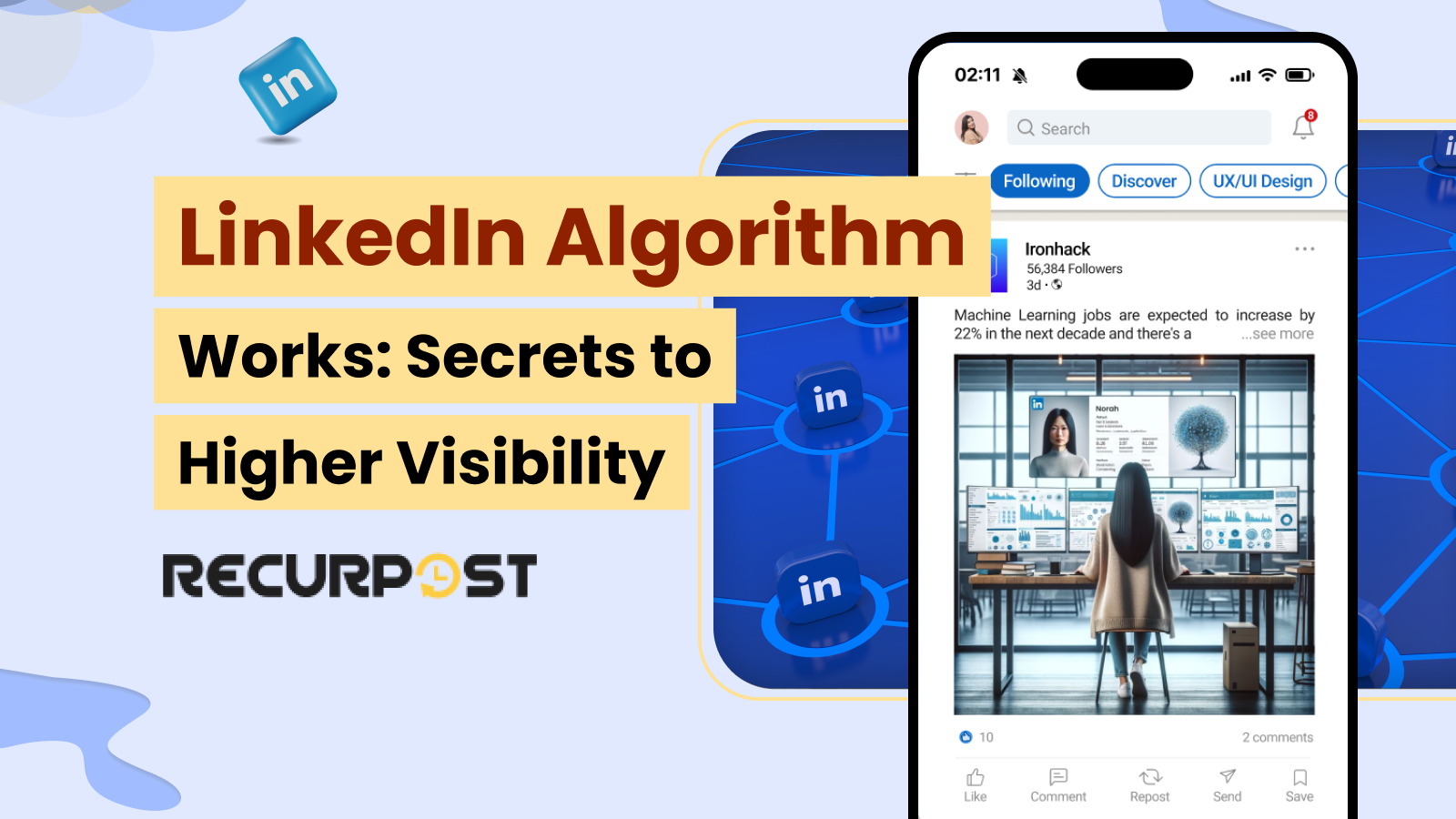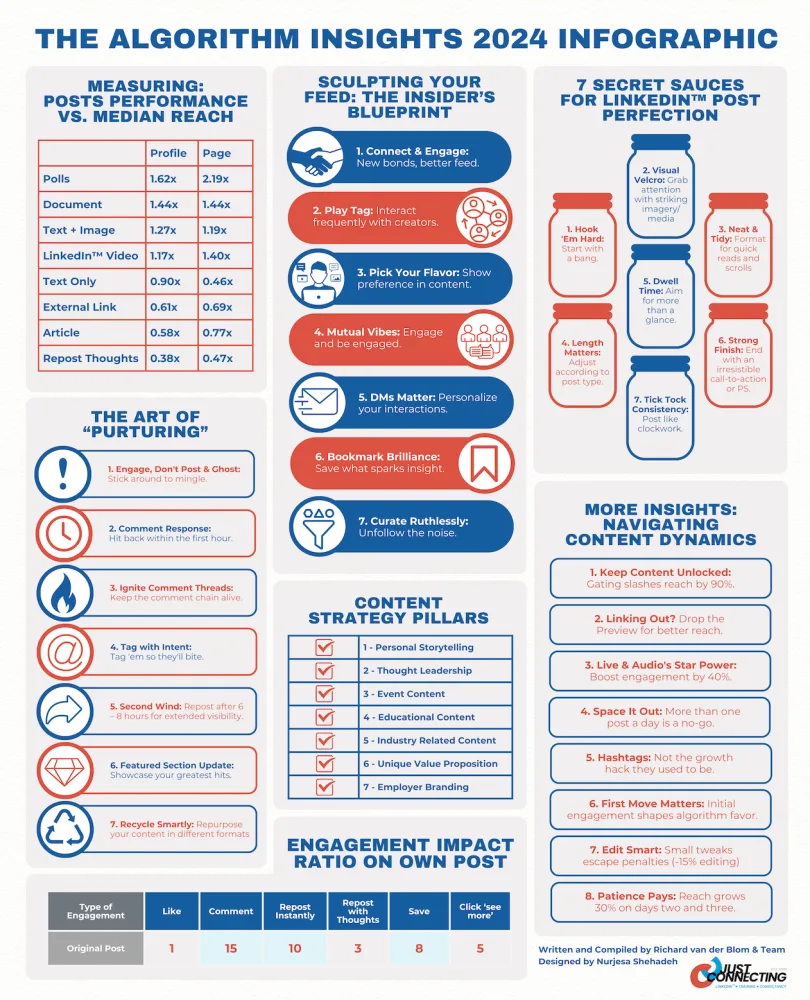Why Isn’t Anyone Seeing Your LinkedIn Posts? Here’s What’s Happening
Ever posted something smart or helpful on LinkedIn and got… silence?
No likes. No comments. Maybe a single pity view from your ex-colleague.
It’s not always your content. A lot of times, it’s the LinkedIn algorithm deciding who sees what. And yes, it has its own rules, filters, and signals, all working behind the scenes before your post even reaches your first-degree connections.
The rules have changed in 2025. If you’re not adjusting how you post, your updates might be stuck in a corner of the LinkedIn feed no one ever visits.
This post breaks down how the LinkedIn algorithm works, how it decides what shows up in users’ feeds, and what you can do today to stop wasting your good ideas.
We’ll talk about why thoughtful comments matter more than just likes, what kinds of posts travel further, and how LinkedIn users are beating the system with small tweaks.
Here’s how to fix your reach.
Want to Get Seen on LinkedIn?
Let RecurPost optimize your post timings to align with LinkedIn’s latest algorithm updates. Start your free trial today and enhance your visibility!
What Is the LinkedIn Algorithm?
The LinkedIn algorithm determines which LinkedIn posts show up in users’ feeds based on specific criteria. Every scroll, like, and comment shapes what you see next.
This system analyzes your activity, the topics you engage with, and the people you interact with most frequently. Based on this data, it determines which relevant content gets delivered to you and which gets buried.
That means when you post something, the LinkedIn algorithm determines if it’s worth showing to your first-degree connections or no one at all.
It uses machine-learning models that analyze LinkedIn user behavior. When people spend time on certain posts, reply with meaningful interactions, or click without scrolling quickly past, the algorithm identifies these posts as potentially valuable content.
This isn’t just about the post itself. Your entire LinkedIn profile, past performance, and interaction patterns all influence what happens after you hit publish.
This explains why many people feel their posts are invisible. Without understanding how the LinkedIn algorithm works, posts often disappear into the void.

How the LinkedIn Algorithm Works: 3 Stages That Decide Your Reach
LinkedIn posts go through a 3-step evaluation process before reaching followers, which determines whether content gets buried, tested, or boosted.
The LinkedIn algorithm works through these steps:
1. The Initial Quality Filter
Your content reaches the first checkpoint immediately after posting.
The algorithm scans your post and categorizes it as: spam, low-quality content, or high-quality content.
If you’ve packed it with external links, too many hashtags, or clickbait, it might get flagged. That’s why avoiding terms like “You won’t believe this” or posting massive link dumps can hurt reach.
Tip: Keep it clean. Share valuable content without stuffing your post. If you need to add links, place them in the first comment.
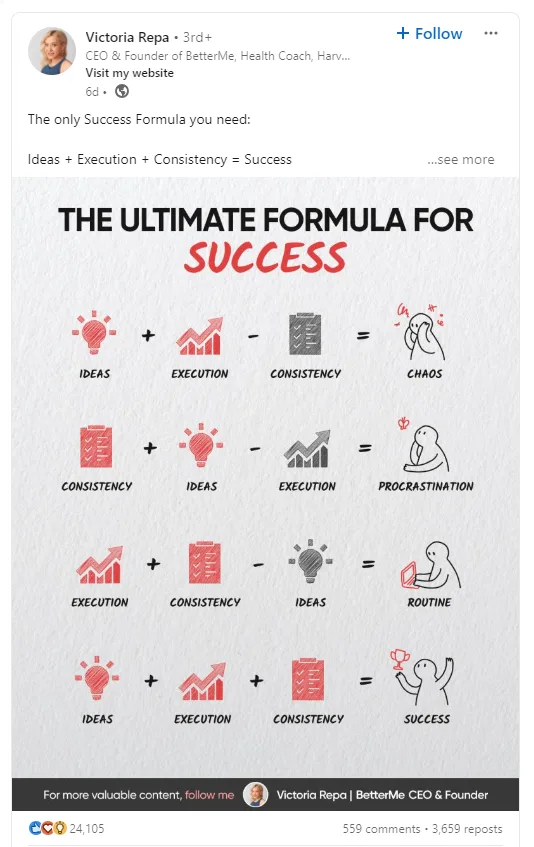
2. Engagement Testing Phase
Posts that pass the filter receive a short trial run.
For approximately one hour, the LinkedIn algorithm shows your content to a few first-degree connections and tracks engagement: likes, shares, thoughtful comments, reading time, and “see more” clicks.
This early user feedback indicates whether your content holds attention or gets skipped.
Tip: Post when you’re available. If someone comments and you reply fast, it boosts engagement signals and gives your post a better shot.
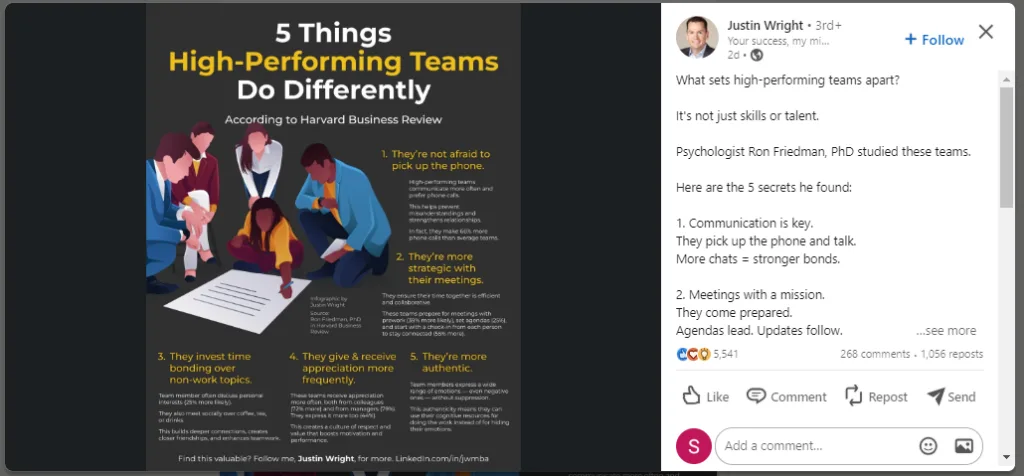
3. Extended Distribution
Posts performing well with that initial test group graduate to wider distribution.
The LinkedIn algorithm then determines whether to show your post to immediate and extended networks, like second- and third-degree connections, or to relevant users interested in similar topics.
Past performance significantly impacts this decision. The algorithm gives more trust to accounts whose earlier LinkedIn posts performed well.
Tip: If something worked once, try reposting it after a few weeks. Change the post format, update the headline, or turn it into video content.
For instance, a post made a while ago by an IBM employee is becoming more and more popular. Because I followed the IBM company page, LinkedIn is alerting me to the fact that you should also check out this post, which is going viral.
Notification from LinkedIn:
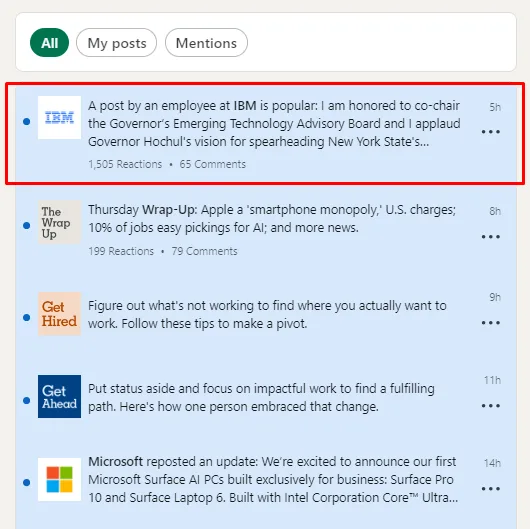
Pages I followed:
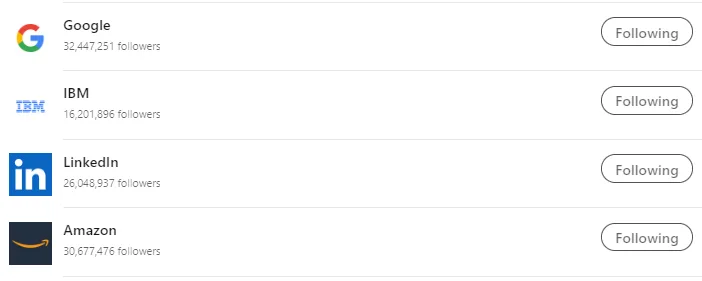
By understanding and optimizing for these key factors, you can increase the chances of your content being seen and engaged with by your target audience on LinkedIn.
Struggling to Beat LinkedIn’s Algorithm?
With RecurPost, you can time your posts perfectly to maximize engagement and visibility. Try it free today and take control of your LinkedIn presence!
What Makes a Post Rank Higher? Key Factors the LinkedIn Algorithm Looks At
The LinkedIn algorithm evaluates specific signals before promoting a post. Key factors include:
1. Relevance to the User
The algorithm analyzes posts for keywords, hashtags, and topics matching a user’s interests based on past behavior, including previous likes, shares, and comments.
Posts aligning with users’ past actions have higher visibility chances, especially when matching industry insights or trending topics from their field.
For increased visibility, use hashtags your target audience follows and terminology they value.
2. Expertise and Credibility
Your LinkedIn profile significantly impacts this factor. Profiles that are complete, have endorsements, and demonstrate consistent posting with valuable insights receive more algorithmic trust.
When past content performs well, LinkedIn gives more trust to your future content.
Maintain an active professional network and updated profile to establish your digital credibility.
3. Engagement Quality
Engagement quality varies significantly. While 20 quick likes are beneficial, a few thoughtful comments sparking discussion carry more algorithmic weight.
The algorithm measures interaction time, reading duration, “see more” clicks, and replies. Posts generating meaningful engagement are classified as high-quality content.
Ask questions, share opinions, and encourage conversation.
4. Strength of Connection
LinkedIn prioritizes first-degree connections but differentiates among them based on interaction history.
Each relationship receives a score based on interaction frequency, messaging, comments, profile views, and other factors. Regular engagement with connections increases the likelihood of your posts appearing in their feeds.
Periodically remove inactive connections to strengthen your active network and improve engagement rates.
Why Your Connections Matter More Than You Think
First-degree connections receive priority in the LinkedIn algorithm. Your posts initially appear to people you’ve connected with rather than random followers or strangers.
This “connections first” approach maintains LinkedIn’s personal nature by prioritizing content from known connections, followed pages, and accounts with meaningful interaction history.
Posts containing valuable insights won’t reach their potential if your network consists primarily of inactive connections.
Tip: Go through your list once every few months. Remove people who don’t engage or aren’t part of your target audience. This small cleanup can lift your engagement rate and help your posts reach the right people.
This is also where employee advocacy makes a big difference. If your coworkers like or comment on your posts, it boosts reach fast because you already have a strong interaction history with them.
The Kinds of Posts the LinkedIn Algorithm Loves in 2025
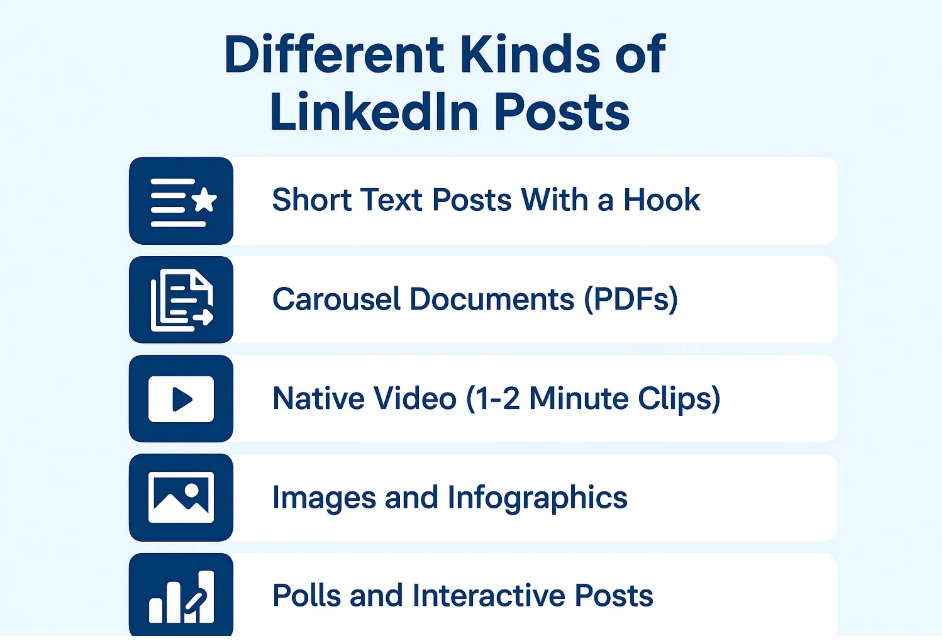
Post performance varies by format. The LinkedIn algorithm favors certain formats based on user engagement patterns.
Limiting yourself to long rants or reshared content reduces your reach potential. These formats currently perform best:
1. Short Text Posts With a Hook
Limit text to under 150 characters before the “see more” break. Attention-grabbing openings increase clicks, reads, and comments, signaling the algorithm to expand distribution.
For meaningful engagement, open with a question or bold statement relevant to your target audience.
2. Carousel Documents (PDFs)
Swipeable slides remain highly effective. Present industry insights, statistics, tips, or checklists across 5–10 pages to stop scrolling and increase reading time.
LinkedIn rewards these posts for their clean presentation and ability to keep users on the platform.
3. Native Video (1–2 Minute Clips)
Video content drives engagement when properly executed. Short clips with captions perform particularly well for quick how-tos or team updates.
Upload video files directly rather than linking to YouTube or Vimeo, as the algorithm favors native content.
4. Images and Infographics
Clear visuals capture attention effectively. Infographics containing valuable content or statistics generate saves and shares. Include alt text for accessibility and to help LinkedIn understand your image content.
5. Polls and Interactive Posts
Polls generate quick interaction, especially when followed by comments explaining results or requesting thoughts. This second wave of replies strengthens your engagement signals.
Use 3–4 answer options with a straightforward question.
The Mistakes That Hurt Your Reach (Without You Even Realizing)
Some posts with excellent ideas fail to gain traction because they violate subtle algorithmic rules. Avoid these common mistakes to improve visibility in users’ feeds:
1. Too Many Hashtags or Links
Excessive hashtags or external links create a spammy appearance. The algorithm categorizes this as low-quality content and typically restricts reach.
Use 3–5 relevant hashtags and place outbound links in the first comment rather than the post itself.
2. Using Engagement Bait
While phrases like “Comment YES if you agree” may generate quick replies, LinkedIn’s algorithm now effectively identifies and penalizes this engagement bait.
Focus on meaningful interactions by asking substantive questions or sharing content that merits thoughtful responses.
3. Posting Without a Schedule
If you post three times this week and disappear for two weeks, the algorithm notices. It prefers accounts that show up regularly, not just when they feel like it.
A simple content calendar helps. Just 2–5 posts per week are enough to keep your professional network warm.
4. Ignoring the Comments
You post. People reply. You vanish.
That’s a missed opportunity. The LinkedIn algorithm pays attention to conversations. If your post starts a discussion but you don’t reply, it sees that as a dead end.
Take 10–15 minutes after posting to reply fast. That early, immediate engagement matters more than you think.
How to Post Smarter on LinkedIn (Not Just More)
You don’t need to post every day to grow. You just need to post better. The LinkedIn algorithm picks up on small habits, such as when you post, how often, and how you interact.
Here’s how to sharpen your content strategy without burning out:
1. Timing and Frequency Matter
Posting during peak business hours gives your post the best shot. The LinkedIn algorithm performs best when you post between 8-10 AM and 12-2 PM on Tuesday through Thursday. These windows capture professionals checking LinkedIn before meetings and during lunch breaks. You also want to keep a steady pace: aim for 2 to 5 LinkedIn posts each week.
Consistency helps the algorithm trust your personal account. Gaps in posting can drop your momentum.
2. Reply Fast to Boost Reach
The first two hours after posting are critical. That’s when the algorithm watches how your first-degree connections react.
Replying within that window helps encourage engagement and shows you’re active, not just posting and ghosting.
3. Mix Your Hashtags
Use a mix of broad and niche hashtags. This helps your post reach both your regular LinkedIn audience and new people interested in relevant content.
Example: Don’t just use #marketing, add something like #B2Bmarketing or #contentplanning.
4. Rotate Content Formats
If all you post are plain text updates, the algorithm might stop testing your posts widely.
Mix in carousel documents, video posts, images, and polls to see what content performs best.
5. Look Back Before You Post Again
Every week, check which 3 posts did best. Look at likes, comments, and how long users engaged. Patterns matter.
This kind of light analytics review helps you refine what to keep posting and what to skip.
6. Build a Stronger Network
The algorithm pays attention to your network quality. A stronger circle leads to more reactions.
Send custom invites. Mention shared interests or people. This helps you connect with relevant users, not just grow a number.
How the LinkedIn Algorithm Has Changed (2023–2025)
If you haven’t updated how you post on LinkedIn since 2022, you’re playing with old rules. The LinkedIn algorithm has shifted each year, and those updates affect what shows up in users’ feeds today.
Here’s a quick breakdown:
2023: The End of Engagement Bait
Posts that begged for likes or comments, “Comment YES if you agree!” started getting punished. LinkedIn rolled out stricter filters to catch these patterns. The goal was to clean up low-quality posts and boost meaningful engagement.
2024: Carousels Took the Lead
Swipeable PDFs became the new favorite. They were easy to read, encouraged long-term users to spend time reading, and kept people on the platform. The algorithm started favoring this format over plain text, especially for sharing industry trends and professional advice.
2025: Expertise Becomes the Priority
Now, it’s all about showing posts from people who bring expert knowledge to their field. The algorithm checks your LinkedIn profile, past posts, and how others react to your insights. If your content reads like valuable insights, not fluff, it’ll likely reach more of your immediate and extended networks.
Bottom line: What worked two years ago might actually hurt your LinkedIn performance now.
LinkedIn vs. Other Social Platforms: What Makes It Different?
Posting on LinkedIn isn’t the same as posting on Instagram or X. And the LinkedIn algorithm isn’t trying to copy what works elsewhere either.
What LinkedIn Cares About
LinkedIn is all about work-life ideas, professional network growth, and sharing things that bring valuable insights to your field. It boosts posts that start smart discussions, show real experiences, or offer industry insights your target audience can use.
The algorithm rewards depth. A solid text post or native content with thoughtful replies will go further than a meme.
What the Others Do
On other social media platforms, it’s all about entertainment. Instagram wants slick visuals. X wants speed and reactions. Facebook blends everything, but its algorithm leans toward friends and family moments.
These platforms focus more on trending soundbites and fast visuals. LinkedIn posts, on the other hand, aim for trust, authority, and long-term value.
What works on Instagram won’t land the same way here. On LinkedIn, it’s about relevant content, not going viral.
Behind the Scenes: The Tech That Drives LinkedIn’s Feed
The LinkedIn algorithm isn’t just one big engine. It’s a collection of smaller systems working together, each with a different job. That’s what makes it powerful, and sometimes, unpredictable.
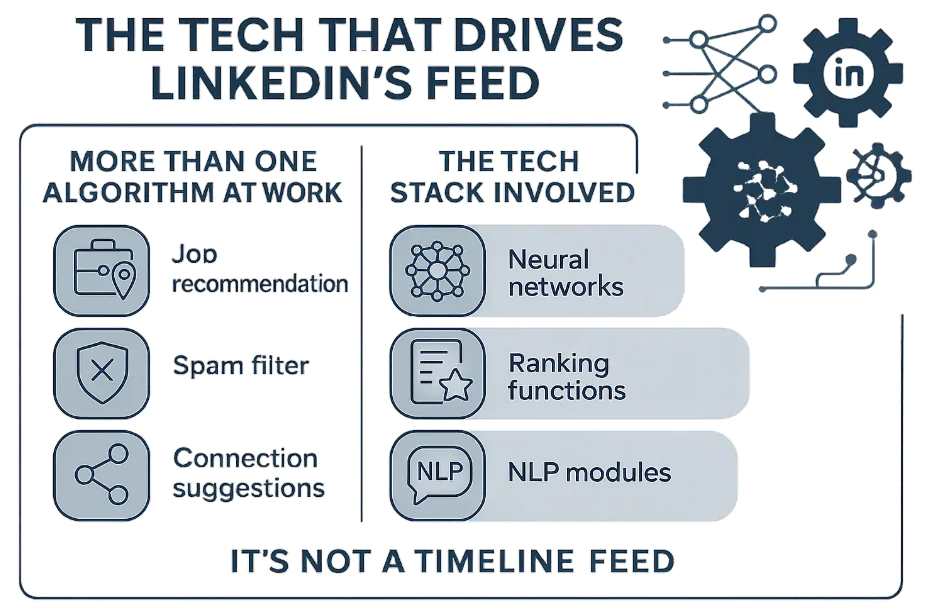
More Than One Algorithm at Work
You’re not just dealing with a single feed algorithm. LinkedIn also runs models for:
- Job recommendations based on skills, location, and interaction history
- Spam filter that blocks fake or repetitive posts
- Connection suggestions based on your professional network and message activity
All of these feed into what you see and who sees you.
The Tech Stack Involved
The platform runs on machine-learning tools like:
- Neural networks that study patterns in post behavior
- Ranking functions that score content for each user
- NLP modules that read text, hashtags, and even image alt text
These models help the platform figure out what’s high-quality content and what might be low-quality content, all in milliseconds.
It’s Not a Timeline Feed
LinkedIn doesn’t show posts in the order they’re shared. It uses an algorithmic feed that scores posts individually for each person.
That means two people could see completely different things, even if they follow the same page or person, because their audience’s interests aren’t the same.
Tip: You’re not just competing with time. You’re competing with relevance, relationship strength, and how the post fits into someone’s recent activity.
Different Types of LinkedIn Algorithms You Should Know
The LinkedIn algorithm is a set of specialized systems, each focused on a specific experience, whether it’s what shows up in your feed, who you find in search, or which company pages appear.
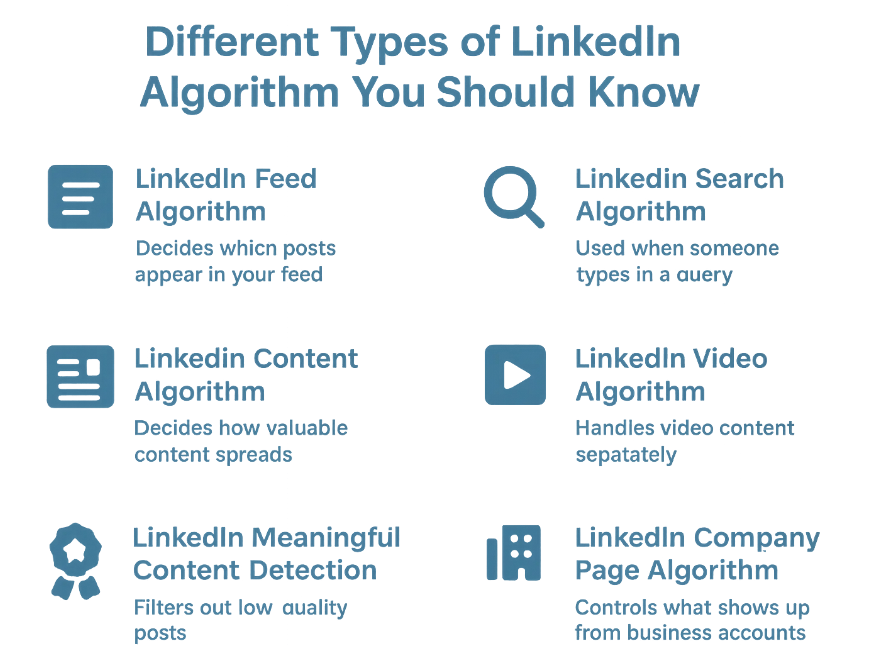
Here’s a breakdown of the key types:
1. LinkedIn Feed Algorithm
This is the one we’ve focused on the most. It decides which LinkedIn posts appear in your users’ feeds.
It considers:
- Relevance to your skills, job title, interests, and industry insights
- How recently was the content posted
- Engagement from your first-degree connections and extended networks
- The author’s history and LinkedIn performance
Timely, relevant content from credible profiles rises to the top.
2. LinkedIn Search Algorithm
Used when someone types in a query. It looks for:
- Matching keywords in your headline, job title, and summary
- How close your profile is to the searcher (same network or group)
- How optimized is your LinkedIn profile?
Add industry-specific keywords to your headline and experience sections.
3. LinkedIn Content Algorithm
This one decides how valuable content spreads. It prioritizes:
- Posts with strong engagement signals (shares, saves, thoughtful comments)
- Posts that match your audience’s interests
- Visual content, like images and video posts
Good formatting and strong hooks improve how your post performs.
4. LinkedIn Video Algorithm
Handles video content separately. It looks for:
- Watch time and whether people watch until the end
- How often is it shared or rewatched
- If the topic matches the user’s recent activity
Short, captioned videos (under 2 minutes) tend to get more reach.
5. LinkedIn Meaningful Content Detection
This filters out low-quality posts and favors deeper interaction.
It boosts:
- Meaningful interactions in comments
- Posts that invite constructive discussion
- Content from users with expert knowledge on the topic
Don’t settle for likes. Ask questions that get thoughtful replies.
6. LinkedIn Company Page Algorithm
This one controls what shows up from business accounts.
It prioritizes:
- Companies you follow
- Posts from employees you engage with
- Pages connected to topics or jobs you’ve searched
Encourage employee advocacy by getting your team to engage with your posts.
Not All Feeds Are the Same: Region and Device Make a Difference
Geographic location and device type influence how the LinkedIn algorithm displays and ranks your content for different audiences.
Regional Differences Matter
If you’re posting for a global LinkedIn audience, know that moderation and ranking rules can change by country. Some regions have tighter filters around promotional content or different rules for external links.
Also, LinkedIn’s natural language processing tools adapt based on the main language in that region. That means phrasing, slang, or even the way you ask a question can impact how well the system reads and promotes your post.
Tip: Use simple language and clear terms, especially if your audience includes non-native English speakers.
Device Settings Shape the Experience
Most LinkedIn users scroll on mobile. Mobile behaves differently from desktop:
- Video content may autoplay on one but not the other
- Comment threads show fewer replies on mobile
- Formatting, like spacing and line breaks, can look different
Tip: Before posting, preview your content on both mobile and desktop to make sure it’s clean and readable everywhere.
A Simple Plan to Boost LinkedIn Performance in 30 Days
You don’t need fancy tools or a big team to track how your LinkedIn posts are doing. A simple system can help you measure progress and adjust fast, just the way the LinkedIn algorithm likes it.
Rate Your Posts Like This (1–5 Scale)
After each post, give it a score in three areas:
- Relevance: Did it match your target audience and topic?
- Engagement: How many likes, shares, or thoughtful comments?
- Expertise: Did it show your professional advice or insights?
Keep it simple. You don’t need exact numbers, just patterns over time.
Let’s break it down week by week:
Your 30-Day Action Plan
Week 1: Audit & Set Benchmarks
Look at your last 5–10 posts. Which ones did best? What content formats did you use? What time did you post? Set a baseline.
Week 2: Try New Formats
Post a carousel document. Test a short video post. Try a text post with a strong hook. Watch how each format performs.
Week 3: Tweak Hashtags and Timing
Use your post data to adjust hashtags, mix in broad and niche. Post at different times and track which ones get early traction.
Week 4: Review Results and Plan Next Cycle
Look at your top 3 posts. What worked? What didn’t? Set new goals for the next 30 days based on what content your LinkedIn audience responded to.
Tip: Don’t wait months to adjust. LinkedIn rewards people who adapt fast.
Tools That Make LinkedIn Easier (and Smarter)
You don’t have to do all the heavy lifting yourself. The right tools can help you stay consistent, track what content performs, and create posts your target audience actually wants to read.
Here are a few tools that work well with the LinkedIn algorithm:
Scheduling & Analytics
- RecurPost – Great for repurposing and scheduling your best posts. You can also run recurring updates and track performance by post type.
- Hootsuite – Lets you schedule posts and view analytics across platforms.
- Buffer – Simple, clean interface with focus on timing and frequency.
These tools help you post when your audience is active and adjust based on engagement metrics.
Content Design
- Canva: Perfect for quick carousels, infographics, and native content like quote cards or tip slides.
- Visme: Great for more advanced visual design, especially for brands creating high-quality content.
Hashtag Research
- RiteTag: Shows which hashtags are currently getting attention.
- Hashtagify: Helps you find trending tags in your industry and track their reach over time.
Tip: Save a shortlist of 10–15 hashtags relevant to your niche. Rotate them with each post to see which ones draw more meaningful engagement.
Final Thoughts: What the LinkedIn Algorithm Wants from You
By now, one thing’s clear: the LinkedIn algorithm isn’t random. It rewards posts that hit three things:
- Relevance to your target audience
- Expert knowledge from a real human, not fluff
- Meaningful engagement that sparks actual conversation
If you post with intention, respond quickly, and vary your format, LinkedIn will give you more reach, not just to your first-degree connections, but to immediate and extended networks who need what you’re sharing.
What’s Coming Next?
Looking ahead to 2026, expect even more fine-tuning. The algorithm is starting to respond to:
- Real-time AI-driven engagement signals
- Voice notes and audio content
- Deeper personalization based on member activity and behavior patterns
The goal? Show the right content to the right people without them even having to ask for it.
Your Turn
💬 Got a tip that boosted your LinkedIn performance?
Drop it in the comments.
Or better yet, share your own success stories. Tell us what worked, what didn’t, and what you’re trying next. Let’s make LinkedIn better, together.
Dominate the LinkedIn Algorithm!
Use RecurPost to schedule your posts for peak engagement times and boost your LinkedIn visibility. Start your free trial now and watch your reach grow.
FAQ: Quick Answers About the LinkedIn Algorithm
1. How quickly will I see results?
You’ll start to notice early engagement within the first hour if the post hits well with your first-degree connections. Real impact, better reach, and ongoing engagement rate usually show up in 1–2 weeks.
2. How many hashtags should I use?
Stick to 3–5 relevant hashtags. It’s the sweet spot for reach without looking spammy. Mix niche and broad ones to connect with both core and extended target audiences.
3. Does posting a video always outperform text?
Not always. Video content tends to boost engagement, but it depends on the quality and topic. A clear text post with strong insights can still beat a poorly made video.
4. Should I use external links in the post?
Not directly. Putting external links in your caption can hurt visibility. Drop the link in the first comment instead; that keeps your post clean and algorithm-friendly.
5. Can I repost the same content?
Yes, just don’t repeat it word-for-word. Wait 2–3 weeks, update the post format, tweak the headline, or turn it into a carousel document or video post. The LinkedIn algorithm treats it like a fresh post.

Saurabh Chaturvedi is a content writer at RecurPost. Specializing in social media management and marketing, Saurabh is dedicated to crafting engaging and informative articles. His passion for clear, exciting content keeps readers eager for more.

